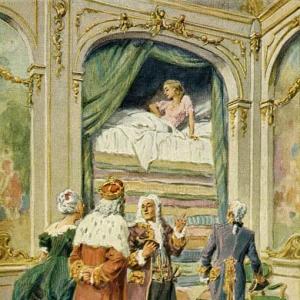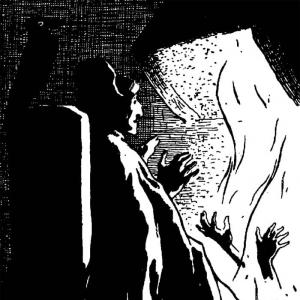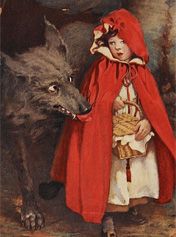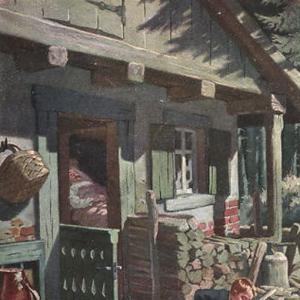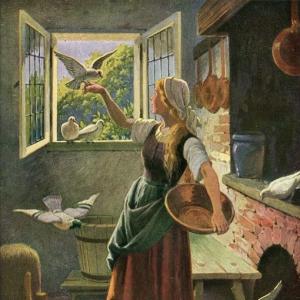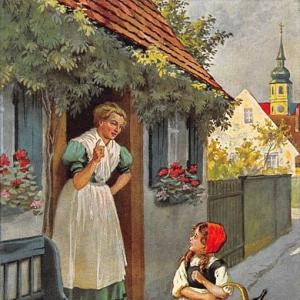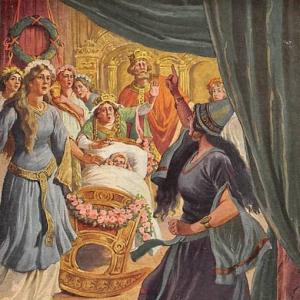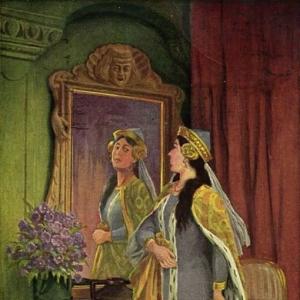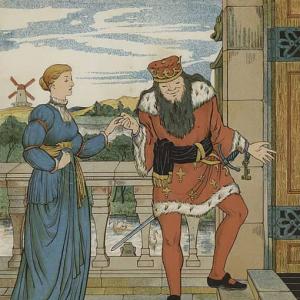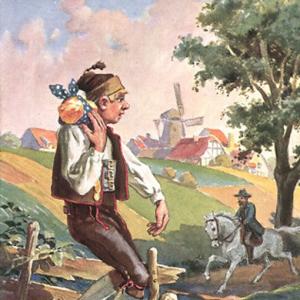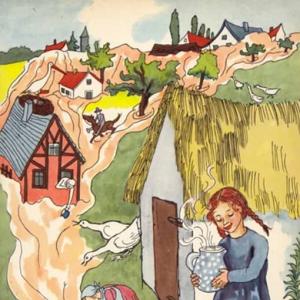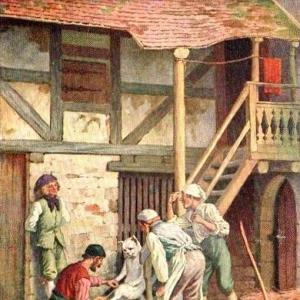Reading time: 14 min
On the last house in a little village the storks had built a nest, and the mother stork sat in it with her four young ones, who stretched out their necks and pointed their black beaks, which had not yet turned red like those of the parent birds. A little way off, on the edge of the roof, stood the father stork, quite upright and stiff. Not liking to be quite idle, he drew up one leg, and stood on the other, so still that it seemed almost as if he were carved in wood. „It must look very grand,“ thought he, „for my wife to have a sentry guarding her nest. They do not know that I am her husband. They will think I have been commanded to stand here, which is quite aristocratic;“ and so he continued standing on one leg.
In the street below were a number of children at play, and when they caught sight of the storks, one of the boldest amongst the boys began to sing a song about them, and very soon he was joined by the rest. These are the words of the song, but each only sang what he could remember of them in his own way.
„Stork, stork, fly away,
Stand not on one leg, I pray,
See your wife is in her nest,
With her little ones at rest. They will hang one,
And fry another;
They will shoot a third,
And roast his brother.“
„Just hear what those boys are singing,“ said the young storks; „they say we shall be hanged and roasted.“
„Never mind what they say. You need not listen,“ said the mother. „They can do no harm.“
But the boys went on singing and pointing at the storks, and mocking at them, excepting one of the boys whose name was Peter. He said it was a shame to make fun of animals, and would not join with them at all. The mother stork comforted her young ones, and told them not to mind. „See,“ she said, „How quiet your father stands, although he is only on one leg.“
„But we are very much frightened,“ said the young storks, and they drew back their heads into the nests.
The next day when the children were playing together, and saw the storks, they sang the song again–
„They will hang one,
And roast another.“
„Shall we be hanged and roasted?“ asked the young storks.
„No, certainly not,“ said the mother. „I will teach you to fly, and when you have learnt, we will fly into the meadows, and pay a visit to the frogs, who will bow themselves to us in the water, and cry ‚Croak, croak,‘ and then we shall eat them up. That will be fun.“
„And what next?“ asked the young storks.
„Then,“ replied the mother, „all the storks in the country will assemble together, and go through their autumn manoeuvres, so that it is very important for every one to know how to fly properly. If they do not, the general will thrust them through with his beak, and kill them. Therefore you must take pains and learn, so as to be ready when the drilling begins.“
„Then we may be killed after all, as the boys say; and hark! they are singing again.“
„Listen to me, and not to them,“ said the mother stork. „After the great review is over, we shall fly away to warm countries far from hence, where there are mountains and forests. To Egypt, where we shall see three-cornered houses built of stone, with pointed tops that reach nearly to the clouds. They are called Pyramids, and are older than a stork could imagine; and in that country, there is a river that overflows its banks, and then goes back, leaving nothing but mire. There we can walk about, and eat frogs in abundance.“
„Oh, o–h!“ cried the young storks.
„Yes, it is a delightful place. There is nothing to do all day long but eat, and while we are so well off out there, in this country there will not be a single green leaf on the trees, and the weather will be so cold that the clouds will freeze, and fall on the earth in little white rags.“ The stork meant snow, but she could not explain it in any other way.
„Will the naughty boys freeze and fall in pieces?“ asked the young storks.
„No, they will not freeze and fall into pieces,“ said the mother, „but they will be very cold, and be obliged to sit all day in a dark, gloomy room, while we shall be flying about in foreign lands, where there are blooming flowers and warm sunshine.“
Time passed on, and the young storks grew so large that they could stand upright in the nest and look about them. The father brought them, every day, beautiful frogs, little snakes, and all kinds of stork-dainties that he could find. And then, how funny it was to see the tricks he would perform to amuse them. He would lay his head quite round over his tail, and clatter with his beak, as if it had been a rattle; and then he would tell them stories all about the marshes and fens.
„Come,“ said the mother one day, „Now you must learn to fly.“ And all the four young ones were obliged to come out on the top of the roof. Oh, how they tottered at first, and were obliged to balance themselves with their wings, or they would have fallen to the ground below.
„Look at me,“ said the mother, „you must hold your heads in this way, and place your feet so. Once, twice, once, twice– that is it. Now you will be able to take care of yourselves in the world.“
Then she flew a little distance from them, and the young ones made a spring to follow her; but down they fell plump, for their bodies were still too heavy.
„I don’t want to fly,“ said one of the young storks, creeping back into the nest. „I don’t care about going to warm countries.“
„Would you like to stay here and freeze when the winter comes?“ said the mother, „or till the boys comes to hang you, or to roast you?– Well then, I’ll call them.“
„Oh no, no,“ said the young stork, jumping out on the roof with the others; and now they were all attentive, and by the third day could fly a little. Then they began to fancy they could soar, so they tried to do so, resting on their wings, but they soon found themselves falling, and had to flap their wings as quickly as possible. The boys came again in the street singing their song:–
„Stork, stork, fly away.“
„Shall we fly down, and pick their eyes out?“ asked the young storks.
„No; leave them alone,“ said the mother. „Listen to me. That is much more important. Now then. One-two-three. Now to the right. One-two-three. Now to the left, round the chimney. There now, that was very good. That last flap of the wings was so easy and graceful, that I shall give you permission to fly with me to-morrow to the marshes. There will be a number of very superior storks there with their families, and I expect you to show them that my children are the best brought up of any who may be present. You must strut about proudly– it will look well and make you respected.“
„But may we not punish those naughty boys?“ asked the young storks.
„No; let them scream away as much as they like. You can fly from them now up high amid the clouds, and will be in the land of the pyramids when they are freezing, and have not a green leaf on the trees or an apple to eat.“
„We will revenge ourselves,“ whispered the young storks to each other, as they again joined the exercising.
Of all the boys in the street who sang the mocking song about the storks, not one was so determined to go on with it as he who first began it. Yet he was a little fellow not more than six years old. To the young storks he appeared at least a hundred, for he was so much bigger than their father and mother. To be sure, storks cannot be expected to know how old children and grown-up people are. So they determined to have their revenge on this boy, because he began the song first and would keep on with it. The young storks were very angry, and grew worse as they grew older. So at last their mother was obliged to promise that they should be revenged, but not until the day of their departure.
„We must see first, how you acquit yourselves at the grand review,“ said she. „If you get on badly there, the general will thrust his beak through you, and you will be killed, as the boys said, though not exactly in the same manner. So we must wait and see.“
„You shall see,“ said the young birds, and then they took such pains and practised so well every day, that at last it was quite a pleasure to see them fly so lightly and prettily. As soon as the autumn arrived, all the storks began to assemble together before taking their departure for warm countries during the winter. Then the review commenced. They flew over forests and villages to show what they could do, for they had a long journey before them. The young storks performed their part so well that they received a mark of honor, with frogs and snakes as a present. These presents were the best part of the affair, for they could eat the frogs and snakes, which they very quickly did.
„Now let us have our revenge,“ they cried.
„Yes, certainly,“ cried the mother stork. „I have thought upon the best way to be revenged. I know the pond in which all the little children lie, waiting till the storks come to take them to their parents. The prettiest little babies lie there dreaming more sweetly than they will ever dream in the time to come. All parents are glad to have a little child, and children are so pleased with a little brother or sister. Now we will fly to the pond and fetch a little baby for each of the children who did not sing that naughty song to make game of the storks.“
„But the naughty boy, who began the song first, what shall we do to him?“ cried the young storks.
„There lies in the pond a little dead baby who has dreamed itself to death,“ said the mother. „We will take it to the naughty boy, and he will cry because we have brought him a little dead brother. But you have not forgotten the good boy who said it was a shame to laugh at animals: we will take him a little brother and sister too, because he was good. He is called Peter, and you shall all be called Peter in future.“
So they all did what their mother had arranged, and from that day, even till now, all the storks have been called Peter.
 Learn languages. Double-tap on a word.Learn languages in context with Childstories.org and Deepl.com.
Learn languages. Double-tap on a word.Learn languages in context with Childstories.org and Deepl.com.Backgrounds
Interpretations
Adaptions
Summary
Linguistics
„The Storks“ is a fairy tale written by the famous Danish author Hans Christian Andersen. Born on April 2, 1805, in Odense, Denmark, Andersen is best known for his collection of fairy tales, which have been translated into numerous languages and adapted into various forms of art and entertainment. Some of his most popular stories include „The Little Mermaid,“ „The Ugly Duckling,“ „The Emperor’s New Clothes,“ and „The Snow Queen.“
Hans Christian Andersen’s fairy tales often combine elements of magic and fantasy with moral lessons, making them accessible and engaging for children and adults alike. While his stories were not initially intended for a young audience, they gained popularity among children due to their imaginative nature and memorable characters.
„The Storks“ was first published in 1839 as part of a collection called „Fairy Tales Told for Children. New Collection. First Booklet.“ The story is one of Andersen’s lesser-known tales, but it still offers valuable lessons and themes, as discussed in the previous interpretation.
Andersen’s stories have had a significant impact on children’s literature and have influenced many authors and artists over the years. His works continue to be celebrated and cherished for their timeless appeal and universal themes.
„The Storks“ by Hans Christian Andersen can be interpreted in several ways, exploring themes such as respect for animals, the consequences of one’s actions, and the power of compassion.
Respect for animals: One of the central themes in the story is the need to respect and treat animals kindly. The tale demonstrates the emotional impact of the children’s mockery on the storks and highlights the good character of the boy Peter, who defends the birds. This theme serves as a reminder that animals have feelings and should not be subjected to ridicule or mistreatment.
Consequences of one’s actions: The story also emphasizes the consequences of one’s actions, particularly when it comes to mistreating others. The children who mock the storks eventually face the consequences of their actions when the storks take their revenge. The naughty boy who starts the song is given a dead baby, while the other children receive siblings as a reward for not participating in the song. This teaches the importance of considering the effects of one’s actions on others and the potential repercussions.
The power of compassion: Peter, the boy who defends the storks, serves as a symbol of compassion and kindness. His empathy towards the storks not only earns him their gratitude but also results in him receiving a brother and sister. This theme highlights the power of compassion and the positive outcomes that can result from treating others, including animals, with kindness and empathy.
Overcoming adversity: The young storks face various challenges, including learning to fly, the possibility of being killed during the autumn review, and dealing with the ridicule from the village children. Despite these obstacles, they persevere and eventually excel in the review. This theme illustrates the importance of resilience and determination in overcoming adversity.
The importance of community and family: The storks rely on their community, particularly their parents, to learn how to fly, survive the review, and navigate the challenges they face. The story underscores the significance of community support and family bonds in achieving success and overcoming challenges.
In summary, „The Storks“ by Hans Christian Andersen is a tale that teaches valuable lessons about respect for animals, the consequences of one’s actions, compassion, resilience, and the importance of community and family.
„The Storks“ by Hans Christian Andersen has been adapted into various forms of media, including:
Films and TV shows: The story has been adapted into several animated films and TV shows, including a Soviet animated film in 1975, a German animated TV series in 1995, and an animated TV special in Denmark in 2007.
Picture books: Several picture books have been published based on the story, with illustrations that bring the characters and setting to life.
Plays and stage adaptations: „The Storks“ has been adapted into a stage play for children, with actors playing the characters and bringing the story to life in a live theatrical setting.
Musical adaptations: „The Storks“ has also been adapted into a musical play for children, with original songs and choreography that help tell the story and bring the characters to life.
Literary adaptations: The story has been adapted into various forms of literature, including children’s storybooks, retellings in different languages, and adaptations for young adult readers.
Overall, the enduring popularity of „The Storks“ has led to numerous adaptations in various forms of media, each one bringing their own unique interpretation of the classic tale.
„The Storks“ by Hans Christian Andersen is a fairy tale about a family of storks living in a village. The mother stork is in her nest with her four young ones, while the father stands guard on the edge of the roof. The village children often tease the storks by singing a mocking song about them being killed, except for one good boy named Peter, who defends the storks.
The mother stork teaches her children to fly and prepares them for the annual autumn review, during which all the storks must demonstrate their flying abilities. They are warned that if they fail, the general will kill them. Meanwhile, the young storks seek revenge on the children who mock them. The mother stork agrees to help, but only after the review.
The young storks excel in the review and are eager to exact their revenge. The mother stork tells them about a pond where little babies await storks to deliver them to their parents. She suggests they bring a baby to each child who did not sing the mocking song, but for the boy who started the song, they will bring a dead baby. As for the good boy, Peter, they will bring him a little brother and sister.
The young storks carry out their plan, and the naughty boy who started the mocking song is heartbroken to receive a dead baby. The other children receive siblings as rewards for not participating in the song. From that day forward, all storks are named Peter in honor of the good boy who defended them.
The fairy tale „The Storks“ by Hans Christian Andersen employs several linguistic and narrative techniques that highlight the moral themes and cultural context of the story.
Below is an analysis of some of these elements:
Narrative Point of View and Style
Third-Person Narration: The story is told in the third person, which allows for an omniscient perspective. This enables Andersen to delve into the thoughts and feelings of both human and animal characters. The narrative voice seamlessly transitions between the perspectives of the stork family and the human children who mock them.
Simple and Direct Language: Andersen uses straightforward language accessible to children, the primary audience for fairy tales. This simplicity aids in communicating the story’s moral lessons clearly.
Characterization
Anthropomorphism: The storks are anthropomorphized, possessing human-like emotions and motivations. This technique allows readers to empathize with the stork family and understand their perspective. The father stork’s pride and the mother stork’s protective nature are especially human traits.
Variety in Human Characters: The children in the story are depicted with distinct attributes. Peter, who refuses to mock the storks, embodies kindness and empathy, contrasting sharply with the main boy who insists on singing the mocking song. This dichotomy serves to highlight the virtues of compassion and understanding.
Dialogue and Interaction
Repetitive Dialogue: The repeated song by the boys serves to reinforce the theme of mindless cruelty, illustrating how such behaviors are replicated thoughtlessly. The song itself, with its harsh imagery of the storks being hanged and roasted, conveys the severity of their mockery.
Mother Stork’s Reassurance: The mother stork frequently reassures her young ones, emphasizing the importance of ignoring the cruel words of others and focusing on self-improvement. Her perspective encourages resilience in the face of adversity.
Themes and Morals
Resilience and Perseverance: The stork family’s journey from fledgling uncertainties to graceful flight illustrates the virtues of perseverance and hard work. The young storks‘ initial fear and doubts are overcome through practice and encouragement.
Revenge vs. Forgiveness: The story explores notions of revenge and forgiveness. Initially, the young storks desire revenge on the boy who mocked them. However, their mother guides their retaliation into a more symbolic act, providing gifts to the kind children and a dead baby to the tormentor. This resolution underscores the themes of justice and the impact of one’s actions on others.
Cultural Elements: Andersen incorporates cultural references, such as the storks‘ migration to Egypt and the symbolic delivery of babies, drawing on European folklore where storks are traditionally associated with bringing new life.
Symbolism
Migration and Freedom: The storks‘ migration to warmer climates represents freedom and escape from the harshness of the children’s taunts and the cold winter. It is symbolic of the rewards that lie beyond enduring immediate challenges.
The Dead Baby: The dead baby symbolizes the consequence of cruelty. Given to the mocking boy, it is both a literal and metaphorical depiction of how negative actions can lead to sorrow and loss.
Conclusion
Hans Christian Andersen’s „The Storks“ is rich with linguistic and narrative elements that convey moral lessons about kindness, resilience, and the proper response to cruelty. The use of anthropomorphized storks and simple, direct storytelling makes it an enduring fairy tale that continues to impart wisdom to young readers.
Information for scientific analysis
Fairy tale statistics | Value |
|---|---|
| Translations | DE, EN, DA, ES, IT |
| Readability Index by Björnsson | 25.8 |
| Flesch-Reading-Ease Index | 88 |
| Flesch–Kincaid Grade-Level | 5.1 |
| Gunning Fog Index | 7.7 |
| Coleman–Liau Index | 7.7 |
| SMOG Index | 7.1 |
| Automated Readability Index | 5.6 |
| Character Count | 9.978 |
| Letter Count | 7.565 |
| Sentence Count | 115 |
| Word Count | 1.896 |
| Average Words per Sentence | 16,49 |
| Words with more than 6 letters | 177 |
| Percentage of long words | 9.3% |
| Number of Syllables | 2.288 |
| Average Syllables per Word | 1,21 |
| Words with three Syllables | 53 |
| Percentage Words with three Syllables | 2.8% |

 Facebook
Facebook  Whatsapp
Whatsapp  Messenger
Messenger  Telegram
Telegram Reddit
Reddit
